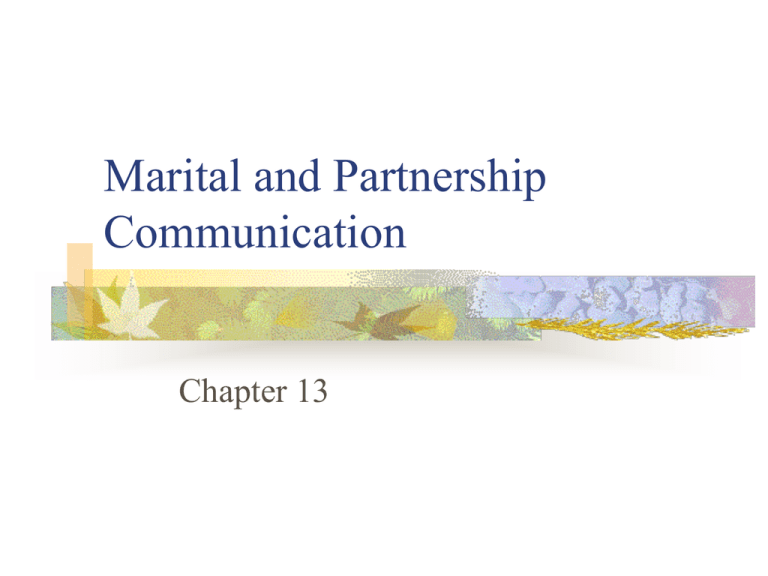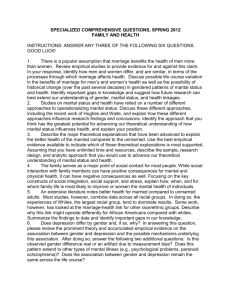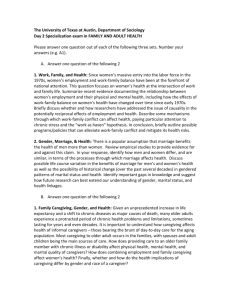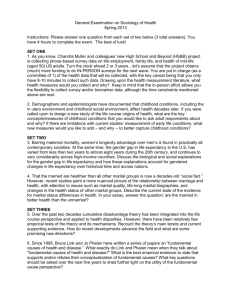Marital and Partnership Communication
advertisement

Marital and Partnership Communication Chapter 13 Gender Differences in Communication Some scholars believe that men and women come from different “cultures” This would explain differences in communication styles between men and women Sex and Gender Sex Gender Traditionally male stereotypes such as strength and aggression Feminine Traits Socially prescribed expectations for roles of people of a particular sex Masculine Traits Biological classification of a male or female Traditionally female stereotypes such as nurturing and emotion Androgynous Traits Some combination of masculine and feminine traits Gender and Nonverbal Communication Research indicates that there are differences in communication styles between men and women However, there are also cultural, contextual, and individual differences in communication styles as well Space and Touch Women tend to exhibit more immediacy behaviors than men Women are more likely to exchange affectionate touches than are men Men use fewer touches during interaction with men than do women in interaction with women Space and Touch continued Men tend to use space and touch to assume positions of authority—and this finding is seen in different cultures, too Men tend to take up more physical space than do women by sprawling out when seated or moving around when standing Facial expressions Women tend to be more expressive than men and better at decoding facial expressions in others Gender influences which expressions we show and which expressions we perceive: Men show more anger, contempt, disgust, and pride Women show more happiness, shame, fear, sadness, and embarrassment Facial expressions continued Women smile more than men do in many social situations There is more social pressure to smile on women than there is on men Women are more likely to smile strategically while men are more likely to smile to express positive emotions Voice and Gesture We can distinguish male and female voices in most cases, even when people whisper Men tend to gesture in more expansive and relaxed postures compared to women Gender and Language Feminine speech… …establishes equality between people …show support for others …attends to the emotional and relational meaning of communication …engages in conversational maintenance work …is personal and concrete …is tentative Gender and Language Masculine speech… …seeks to establish status and control …pursues instrumental objectives …aims for conversational command …is direct and assertive …is abstract …is less emotionally responsive Language Features of Female Communication Intensive adverbs Modifies an adjective References to emotion Any mention of an emotion or feeling Dependent clauses A clause that serves to specify or qualify the words that convey primary meaning Sentence-initial adverbials Answers the question: how?, when?, or where? regarding the main clause Language Features of Female Communication Mean length sentence Uncertainty verbs Hedges Negations The number of words divided by the number of sentences Verb phrases indicating lack of certainty or assuredness Modifiers that indicate a lack of confidence in, or diminished assuredness of the statement A statement of what something is not Language Features of Male Communication References to quantity Direct references to an amount or quantity Elliptical sentences A unit beginning with a capital letter and ending with a period (other end point) in which either the subject or predicate is understood Directives Apparently telling another person what to do Locatives Indicating the location or position of objects Marital Communication Selecting a Partner Teen marriages fail at a higher rate than do marriages of people in their 20s or 30s Similar values, backgrounds, and life goals are correlated with marital success Women are more likely to marry if they do not become single parents prior to marriage Higher education is associated with marital stability Selecting a Partner, continued Cohabitation prior to marriage is not associated with marital success Married sex tends to be more satisfying than single sex Issues that lower the divorce rate: First marriage Higher education (college and above) Married in 20s or 30s (not teens) Not lived with many partners prior to marriage Religious convictions Marriage and Partnership Marriage is a legal, lasting union that is created in a public ritual Weddings are the ritual events that create a marriage Weddings involve a community of people Weddings involve rituals, which are traditional events with great significance to the participants Marital Communication Fitzpatrick’s Marital Typology Marriages differ in terms of: Partner Roles: conventional v. nonconventional Connectedness: interdependent v. autonomous Conflict Behavior: engage v. avoid Marital Communication Fitzpatrick’s Marriage Types Traditionals- conventional ideological values, have high degree of interdependence, share information and intimacy and do not avoid conflict. Independents- non-conventional ideological values, high level of companionship and sharing, psychologically close but autonomous in activities and space. Separates- profess traditional values but place higher degree on autonomy, less companionship and sharing, maintain psychological and physical distance, avoid conflict. Marriage Types & Ideology Ideology Interdependence Conflict Behavior Traditionals Conventional values about marriage High degree; Share info & intimacy. Do not avoid conflicts. Independents Nonconventional values about marriage. High degree of sharing; buddies; low degree of sharing space. Do not avoid conflicts. Separates Profess traditional values but emphasize autonomy Less sharing & companionship; Maintain psych & physical space. Avoid conflicts. Marital Conflict Gottman’s Theory of Marital Ecology Marital Conflict Styles Damaging Forms of Communication Breaking the Cycle Research Results Gottman and his teams can predict with 96% accuracy whether a couple will be together in three years based on observing 45 minutes of interaction 15 minutes neutral 15 minutes positive 15 minutes negative Five basic marital types in terms of conflict resolution behaviors Two types are unstable and will lead to dissolution Three of the types are stable Theory of Marital Ecology Stable Marital Conflict Styles – Couples adopt an emotional-communicative style for dealing with conflict: Validating – openly address conflict, share differences calmly and respectfully, listen attentively, empathize and compromise. Volatile –frequent and intense conflict, hostile, listen poorly, argue fiercely, rarely empathize. One wins, one looses. Avoiding –minimize disagreement, repress or deny conflict, rarely engage, agree to disagree. Marital Ecology Gottman’s research shows that no one stable style is better than another for marital success Overall emotional quality of interaction which is predictive of harmony Benchmark is 5:1 ratio of positive to negative exchanges (yet not all forms of negative communication are equal). Damaging Forms of Negativity The Four Horseman of the Apocalypse Criticism (v. complaint) Contempt Defensiveness Stonewalling Criticism Refers to attacking a spouse’s personality or character Includes three types Passing judgment Bringing in long lists of complaints Indicating lack of trust in a spouse Contempt Refers to the practice of partners insulting one another Globalization of criticism statements Includes Name calling Insults Hostile humor Mockery What is OK? Complaining is OK A Complaint is a specific statement of displeasure directed at a specific action or event A Criticism is much less specific and has blaming language in it A Contempt statement involves language that is intended to insult and psychologically abuse the other Defensiveness Occurs when neither partner takes responsibility for their behaviors Occurs when one perceives or anticipates a threat to face or relational definition by the other Includes Making excuses Cross-complaining Whining Stonewalling Occurs when the communication between the partners has broken down Men are more likely to stonewall and women are more likely to respond defensively Breaking the Negative Cycle Take a break (20 minutes) Learn to Calm Yourself Become Non-defensive learn to respond non-defensively and to minimize defensiveness in others with your messages Validate understand the danger of emotional flooding you can acknowledge the other’s perceptions or feelings without agreeing with them Over-learn the Strategies Domestic Violence Domestic Violence IS violence More than four million incidents against women each year Types of Domestic Violence Physical Battering Sexual Abuse Forced sexual activities Psychological Violence Slapping, hitting, choking, punching, kicking, and using objects as weapons Threats, isolation, extreme jealousy, degradation, threats to children, symbolic violence Property Violence Threatened or actual destruction of property






